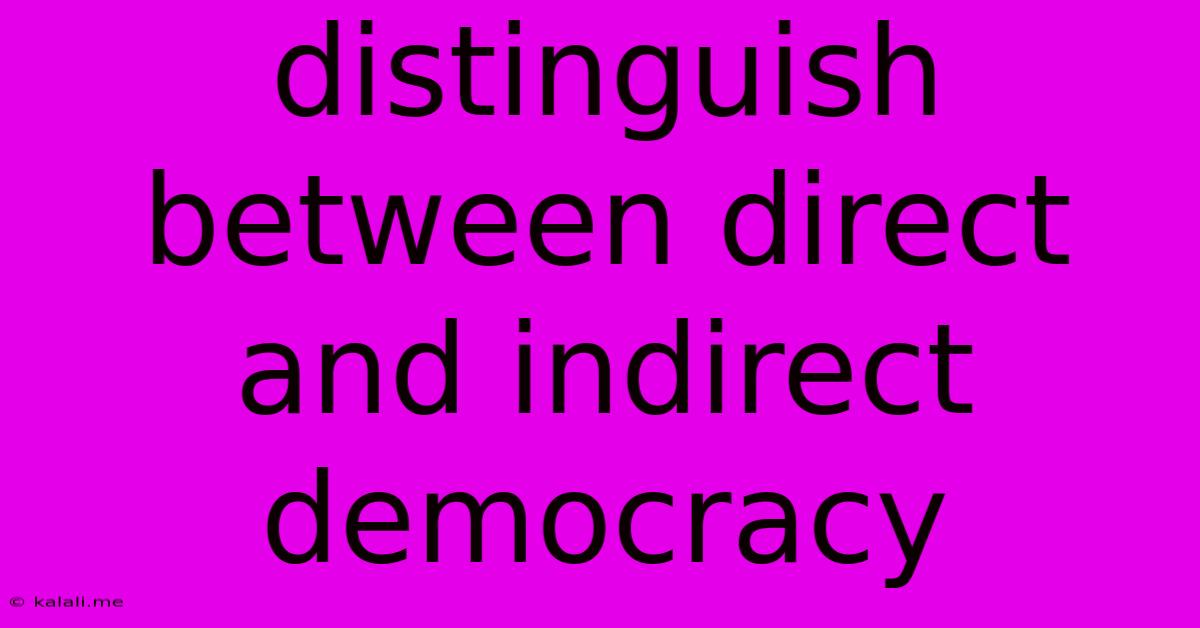Distinguish Between Direct And Indirect Democracy
Kalali
Jun 12, 2025 · 3 min read

Table of Contents
Direct vs. Indirect Democracy: Understanding the Differences
Understanding the nuances between direct and indirect democracy is crucial for anyone interested in political systems and governance. While both aim to give the populace a voice in their government, they achieve this goal through vastly different mechanisms. This article will delve into the core distinctions, exploring the advantages and disadvantages of each system. By the end, you'll have a clear grasp of how these two democratic models operate and their implications for citizen participation.
What is Direct Democracy?
Direct democracy, also known as pure democracy, is a system where citizens directly participate in decision-making. This means that instead of electing representatives to make laws and policies on their behalf, citizens themselves vote on legislation and other matters of governance. Think of it as a direct line from the people to the government, bypassing any intermediary.
Key Characteristics of Direct Democracy:
- Citizen participation: Citizens directly vote on laws and policies.
- Referendums and initiatives: These are common tools used in direct democracies to allow citizens to propose and vote on legislation.
- Limited scalability: Direct democracy works best in smaller communities where it's feasible for everyone to participate actively.
- Potential for majority rule: A risk is that the rights of minorities can be overlooked in favor of the preferences of the majority.
What is Indirect Democracy?
Indirect democracy, also known as representative democracy, is the most common form of democracy practiced today. In this system, citizens elect representatives to make decisions on their behalf. These representatives form a government (such as a parliament or congress) that creates and enforces laws. The elected officials are accountable to the electorate and are typically subject to periodic elections.
Key Characteristics of Indirect Democracy:
- Elected representatives: Citizens choose individuals to represent their interests in government.
- Legislative bodies: Laws are created and debated by elected representatives.
- Scalability: Suitable for large and diverse populations.
- Specialized expertise: Elected officials can often bring specialized knowledge and expertise to policy-making.
- Potential for disconnect: A key concern is the potential for a disconnect between the representatives and the citizens they represent.
Comparing Direct and Indirect Democracy: A Table
| Feature | Direct Democracy | Indirect Democracy |
|---|---|---|
| Decision-making | Citizens directly participate | Representatives make decisions |
| Citizen role | Active, direct participation | Elect representatives, hold them accountable |
| Scalability | Limited, best suited for small communities | Scalable to large populations |
| Efficiency | Can be slow and cumbersome | Generally more efficient |
| Expertise | May lack specialized knowledge | Benefits from specialized knowledge |
| Examples | Referendums, initiatives, ancient Athens | Most modern nations |
Advantages and Disadvantages
Direct Democracy:
Advantages:
- Increased citizen engagement: Promotes a stronger sense of civic duty and responsibility.
- Greater accountability: Representatives are directly accountable to the people.
- More responsive to public opinion: Policies directly reflect the will of the people.
Disadvantages:
- Inefficient and time-consuming: Difficult to organize and manage for large populations.
- Susceptible to manipulation: Can be easily influenced by misinformation or popular opinion.
- Tyranny of the majority: The rights of minorities may be overlooked.
Indirect Democracy:
Advantages:
- Efficient and effective: Allows for quicker decision-making and implementation.
- Specialized expertise: Elected officials bring specialized knowledge and experience.
- Protection of minority rights: Representatives are expected to consider the interests of all citizens.
Disadvantages:
- Reduced citizen engagement: Can lead to apathy and disengagement among citizens.
- Potential for corruption and abuse of power: Representatives may act in their own self-interest rather than the public interest.
- Lack of responsiveness: Policies may not always reflect the will of the people.
Conclusion:
Both direct and indirect democracy have their strengths and weaknesses. Direct democracy fosters greater citizen participation but can be impractical for large populations. Indirect democracy is more efficient and scalable, but can lead to a disconnect between representatives and the people they represent. Many modern nations employ a hybrid system, combining elements of both direct and indirect democracy to leverage the advantages of each. Understanding these differences is key to appreciating the complexities and challenges of democratic governance.
Latest Posts
Latest Posts
-
Which Of The Following Statements About Monetary Policy Is True
Jun 13, 2025
-
What Is The Lcm Of 8 12 15
Jun 13, 2025
-
Which Installation Is Not Covered By The Code
Jun 13, 2025
-
The Largest Portion Of Earths Volume Is
Jun 13, 2025
-
The Device That Connects Two Networks Is A
Jun 13, 2025
Related Post
Thank you for visiting our website which covers about Distinguish Between Direct And Indirect Democracy . We hope the information provided has been useful to you. Feel free to contact us if you have any questions or need further assistance. See you next time and don't miss to bookmark.